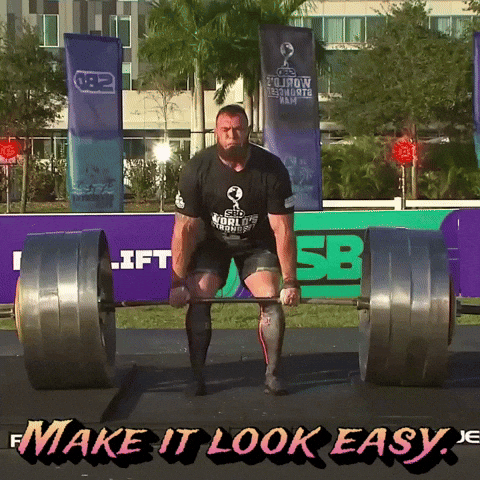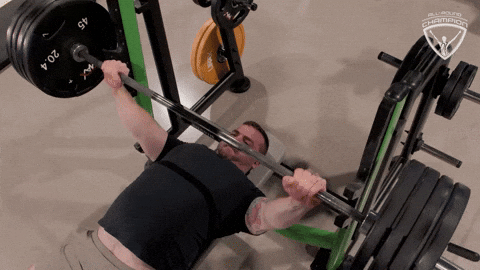How do you build strength in powerlifting
BUILD YOUR OWN PROGRAM
Download our FREE Template by entering below

Strength Training For Powerlifting
When it comes to powerlifting people think of Louie SImmons, RIP, training some of the strongest freaks in the entire world at Westside Barbell. For me, I think of Gene Rychlak bench pressing a ton and seeing how large of a human being a person could be.
Powerlifters are athletes who deadlift, back squat, and bench press. They use the anaerobic alactic or the glycolytic energy system. Powerlifters are doing work typically between five to ten seconds and are possibly doing sets with reps that last thirty to sixty seconds. Some powerlifting coaches implement some steady state cardio to help with recovery or lean athletes out for specific weight classes.

Powerlifters have some semblance of mobility. They also have to have really sound structural integrity to enhance recovery, prevent injuries, and hit optimal technique. Technique rules in powerlifting. Powerlifting athletes need to execute the technique they need specific to their body as well as possible for each lift. Think about the back squat technique. Athletes need to squat to just below 90 degrees, drive up as rapidly as possible, and wait to get cued to come back into the stand. Those are the basics but athletes need to determine their groove, their pattern, their shin angle, their hip angle to their torso, and all the necessary bracing.
The deadlift has athletes pulling from the floor, holding really solid tension, and holding the bar as tight to the center of mass as possible. The knees need to completely lock out to execute the finish. The same mindset comes with the bench press. Athletes need to unrack the bar as smoothly as possible, groove through the eccentric, and feel the nice strong pause before driving through the eccentric position of the movement.
Technique rules. We know we have to work towards enabling the body to lift as much as possible.
The Deadlift
First, are we going to do sumo deadlift or conventional deadlift? I recommend shorter limbed leg individuals should go sumo and longer limbed leg individuals should pull conventional. Just make sure to identify which technique will be used.
As the technique is executed, we have to focus on the pattern of the technical movement. Notice the pattern from off the floor to the knee, as the bar passes the knee, and as the athlete locks out their hips and knees we have to see where the technique falls to the wayside. We essentially want to see where the individual loses the groove–bar creeps forward, pulls onto the toes, hitch like crazy.
We then take that technical weakness and identify the positions where we see musculature weaknesses. Athletes might lack coordination, their hamstrings may be weak, the quads are weak on lockout, their butt shoots-up super, super high, and we are able to, based on the technical model, identify where the technical pattern is suffering and where the musculature weakness is based. That helps us get to the next step.
We can start to employ different movements for two to three periods of training blocks to target specific areas. For example, if we notice a lower back/posterior chain lacks coordination we can really, really load the reverse hyper. If we notice someone’s hamstrings are weak, or they aren’t fast in the lockout, we can target hamstring specific exercises like sliding hamstring curls and nordic hamstring curls. Or maybe the athlete has a weak mid-back and finishes to finish the lockout at the top, hitching like crazy, we can start to do safety bar good mornings to help. We can now piece all this together.
We can figure out how often the athlete can deadlift, where the patterning problems exist, technical problems, and knowing that the deadlift is a technical movement and needs to be executed more often than every ten days, but more like deadlift every week. It doesn’t mean a max attempt all the time, but it can mean pushing the absolute movement once and on another day doing ten sets of doubles or triples to feel the groove and pattern to help the muscles learn how to coordinate better.
In summation, use a technical model, find where the technical weaknesses exist, find the weak muscles and target and isolate them, and remember to practice the movement, reserving one day to pull heavy, heavy, pushing the weight, and another day to find the groove.

The Back Squat
Let’s begin by figuring out what federation the athlete is competing in. Some federations allow a little bit higher back squats. Other federations ask lifters to squat deep. Based on this depth requirement, we can establish a technical model.
With the technical model established, we work on technique. Through technique we can identify areas for growth to be addressed. Ankle mobility? Lower back strength? Weak quads? Well, if the quads are weak, we probably want to go full steam with the low bar squat as the technical model but while training, 12 to 16 weeks out, we train more high bar to target those weak quads.
As we see the technical pattern and what it should be, we can lay out how we can attack the technique and muscles based around the back squat training. I typically recommend training high bar 16 weeks out from a comp with minimal amount of gear; I also recommend training high bar 12 weeks out as well. Now as the time frame is closer to 8 to 10 weeks, the shift to low bar needs to happen to really zero in on that technique.
On top of that, on the dynamic days, implement plyometric movements later in the week to help with the rate coding and increase the power production at a high rate of force development. Contrast methods enable the body to learn how to have greater speed and force development which will help when under the bar in a max effort.
The Bench Press
The temple of the bench press is very similar to the previous lifts. Are we wearing gear? How does that influence our technical focus? The goal is to establish the groove to be the most effective in muscle recruitment. Some athletes have a much tighter elbow tuck and other individuals let their elbows flare more based on limb length. This is where we can start to focus on technical work.
I am a little bit longer-limbed bench presser who has extremely strong triceps with a weaker chest. Because of my strengths and weaknesses, further out from competition I will focus, 8 to 12 weeks, on developing my chest movements. I want to focus on one and a quarter reps and slow eccentrics just above my chest to figure out how to get as much recruitment out of my pecs as possible because once my triceps kick into full gear I can execute and finish.
On the flip, someone with a strong chest and weak triceps, we have to develop their tricep strength. Various grips bench pressing help identify weaknesses as well as target the areas that need more strength development to lead to better performance in competition.
The bench press responds very well to hypertrophy work. Doing sets of seven to twelve reps helps. The bench also responds very well to speed work–pad benches are great for this. Looking at that, we need to identify during what phases we need speed work and hypertrophy work based on technical weaknesses and morphological weak points to help execute the bench with higher poundage to lift more weight.

Strength Template
Day one we are going to do a speed pull. I like to use things like a clean high pull or a snatch pull to a target. The second exercise we are going to get into a strength movement. This is where we can execute the back squat with different variations to increase overall performance with the movement. After the overall heavier movement, we get into accessories. We want to attack weak points in the athletes technique and/or musculature.
So day one is a fast explosive pull, a strength movement, typically a back squat, and then accessories to target the weaknesses.
Day two we will start with an explosive movement. We can do a med ball bench, a behind the neck push press, or even a power jerk. We want to make the nervous system as coordinated as possible. I like to train powerlifters like shot putters, some of the strongest people in the world. The second movement we get into the strength based movement like the bench press, incline bench press, or other absolute strength based movements for the upper body. Following that we want to target weak points with accessory movements to make the body’s structural integrity more solid to bulletproof the execution of the bench press.
Day three we are going to focus on starting with a speed pull as a warm up into a max effort pull. From there, the second exercise will be a squat variation like a zombie squat, paused front squat, or a single-leg squat with a bit more hypertrophy focus. Again, the next movement is accessory work to help with recovery and continuously build and enhance weak points within the entire chain of the body.
Day four we will again start with an explosive upper body work or stability work. Chaos push-ups or push-ups to a box or behind the neck power jerk as exercises to help wake up the nervous system before leading into the strength/hypertrophy movement for the upper body like pushing a dumbbell bench press for six sets of twelve. We can couple that movement with back work to build the contractile strength of the muscle. Then that brings us to the accessories where we are targeting direct weak points.
Recap
We need to know a lot when training for powerlifting. We need to know the movement pattern. We need to know the individual and how their technique is influenced by their limb length; their tendencies; their weak points in their technique; cues to enhance their muscular patterning.
All of these ‘need to know’ lead into the fact that hypertrophy and dynamic work does phenomenal work in increasing the weight on the bar with powerlifting.
We also need to target the specific joints that take a toll from powerlifting. We have to work on the mobility of these areas to improve overall recovery.
And remember, plan 12 to 16 weeks out to make sure it is easier to hit the PR’s at the competition.
Blog Topics

Yo, It's Dane
Welcome to the Garage Strength Blog, where it is my goal to provide you with the experience and knowledge I've gained in the strength and conditioning world over many years of learning from both successes and failures. I train elite-level athletes in a multitude of sports from the high school to professional levels, already producing 5 Olympics and 30+ National Champions. If you want to be the next champion I train, check out my strength programs below!
Start Training With Me

Join for free educational videos EVERY WEEK on strength coaching and athletic performance



